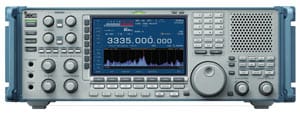Radio Types: Types of Radio Receiver
There are many different types of radio receiver that can be used and designed - each with its own advantages and disadvantages
Radio Receivers Tutorial Includes:
Receiver types
TRF receiver
Crystal radio set
Regen receiver
Super-regen
Superheterodyne radio
Over the years, many different types of radio receiver have been designed.The different types of receiver have arisen out of the needs of the day and the technology available.
Early radio receivers had poor performance compared to those used today. Nowadays with advanced techniques like digital signal processing, and high performance semiconductors and other components, very high performance radios are commonplace.

Image courtesy Icom UK
Radio receiver applications
Todays there are many different applications for radio receivers. Everything from the more traditional broadcast radio receiver to professional communications receivers. In addition to this the explosion in cellular and wireless communications has meant that there are very many different radio receivers needed for different applications.
Each application has its own requirements and as a result, many different types of radio receiver are needed.
Some radio receiver types are much simpler than others, whereas some have higher levels of performance and are not confined by space as much.
In view of the huge difference in requirements and performance levels needed, many different types of radio can be seen these days.
Radio receiver types
Many of the different radio receiver types have been around for many years. The component technology, and in particular semiconductor technology has surged forwards enabling much higher levels of performance to be achieved in a much smaller space.
There is a number of different types of radio:
- Tuned radio frequency, TRF : This type of radio receiver was one of the first that was used. The very first radio receivers of this type simply consisted of a tuned circuit and a detector. Crystal sets were early forms of TRF radios. . . . . . . Read more about the How does a crystal radio work
Later amplifiers were added to boost the signal level, both at the radio frequencies and audio frequencies. There were several problems with this form of receiver. The main one was the lack of selectivity. Gain / sensitivity was also an use. . . . . . Read more about the TRF Radio Receiver - Regenerative receiver: The regenerative radio receiver significantly improved the levels of gain and selectivity obtainable. It used positive feedback and ran at the point just before oscillation occurred. In this way a significant multiplication in the level of "Q" of the tuned circuit was gained. Also major improvements in gain were obtained this way. . . . . . Read more about the Regen Radio Receiver
- Super regenerative receiver: The super regenerative radio receiver takes the concept of regeneration a stage further. Using a second lower frequency oscillation within the same stage, this second oscillation quenches or interrupts the oscillation of the main regeneration – typically at frequencies of around 25 kHz or so above the audio range. In this way the main regeneration can be run so that the stage is effectively in oscillation where it provides very much higher levels of gain. Using the second quench oscillation, the effects of running the stage in oscillation are not apparent to the listener, although it does emit spurious signals which can cause interference locally. Gain levels of over a million are not uncommon using this type of radio receiver. . . . . . Read more about the Super-Regenerative Radio Receiver
- Superheterodyne receiver: The superheterodyne form of radio receiver was developed to provide additional levels of selectivity. It uses the heterodyne or mixing process to convert signals done to a fixed intermediate frequency. Changing the frequency of the local oscillator effectively tunes the radio. . . . . . Read more about the Superheterodyne Radio Receiver
- Direct conversion receiver: This type of radio format converts the signal directly down to the baseband frequency. Initially it was used for AM, Morse (CW) and SSB transmissions, but now it is widely used for digital communications where IQ demodulators are used to take advantage of the variety of phase shift keying, PSK, and quadrature amplitude modulation, QAM signals.
Many of these different types of radio receiver are in widespread use today. Each type of radio has its own characteristics that lend its use to particular applications.
More Essential Radio Topics:
Radio Signals
Modulation types & techniques
Amplitude modulation
Frequency modulation
OFDM
RF mixing
Phase locked loops
Frequency synthesizers
Passive intermodulation
RF attenuators
RF filters
RF circulator
Radio receiver types
Superhet radio
Receiver selectivity
Receiver sensitivity
Receiver strong signal handling
Receiver dynamic range
Return to Radio topics menu . . .


